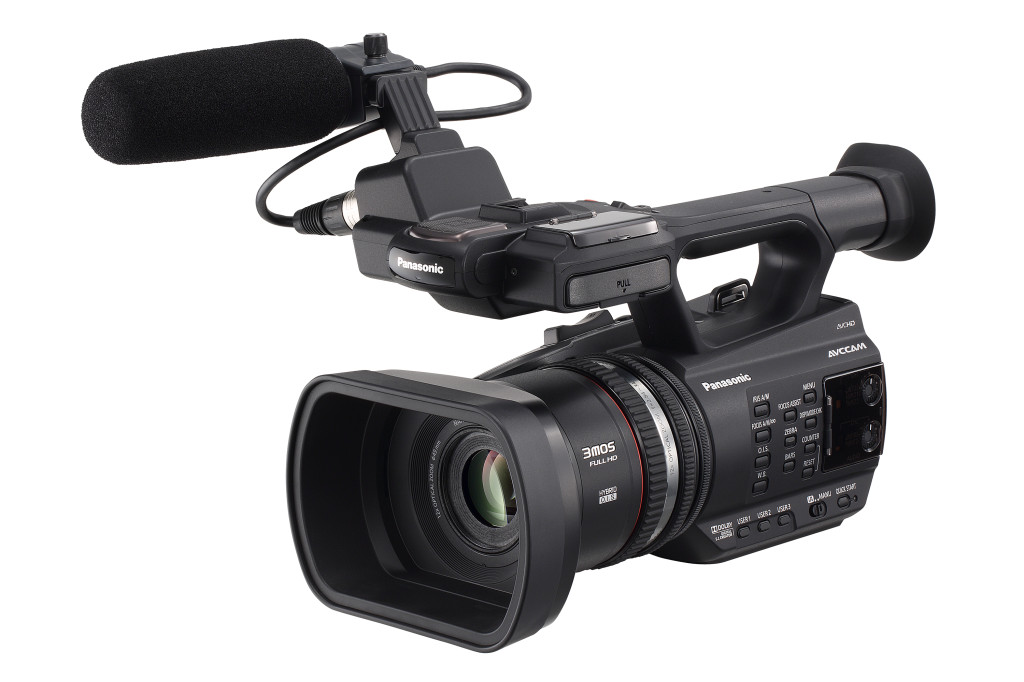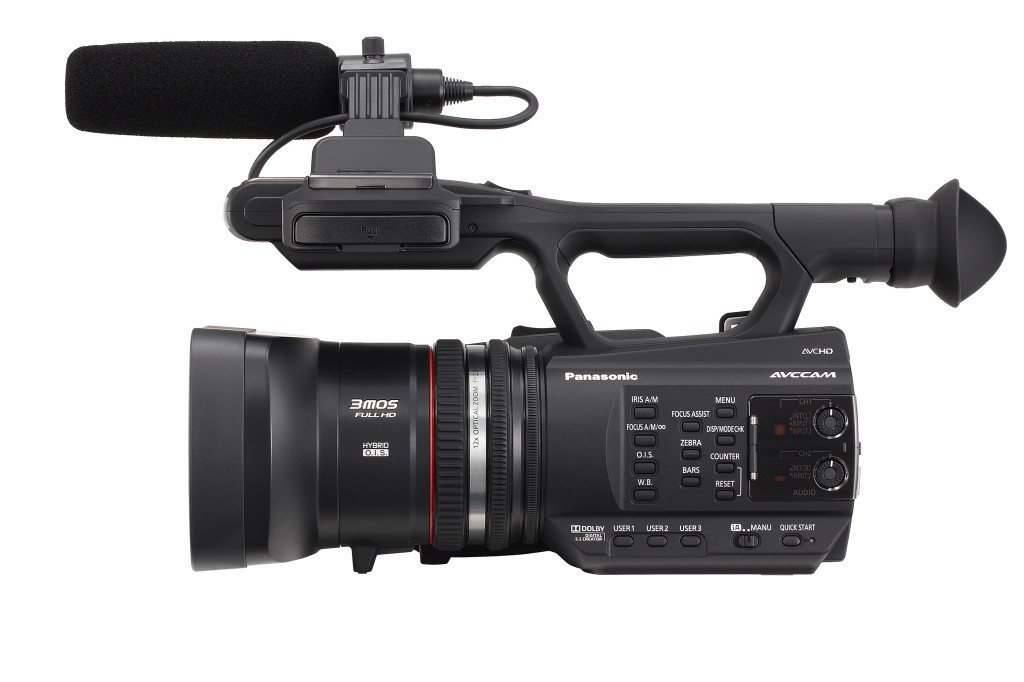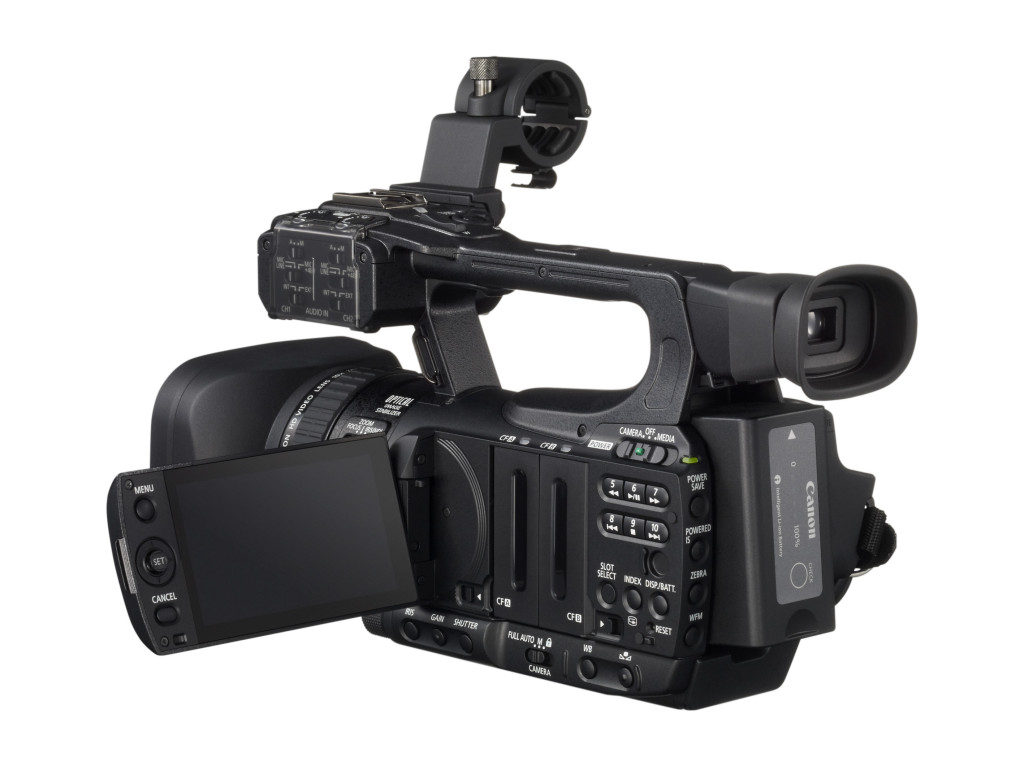Best entry-level pro camcorder
*** Please note: this article has now been superseded by a later edition in October 2014 . Click here to see that newer article or read on for historical interest ***
This category is surprisingly hard to judge. It’s not the level of competition – there are only two real competitors – but that they are each so capable and yet so different.
Those competitors are: the Canon XF100 and the Panasonic AG-AC90. If you’re wondering why cameras such as the JVC GY-HM70 or Sony’s HVR-HD1000 and HXR-MC2000 aren’t included, that’s because they’re not really pro cameras at all despite appearances.
They’re mutton dressed as lamb, consumer-level camcorders wedged into a shoulder-mount body to look more impressive but it’s all gloss and no substance. With mainly touch-screen operated controls and limited “real” manual operation, these are discounted as toys for people who don’t know better.
Whilst Sony’s HXR-NX70 is a possible contender, its diminutive size and water / dustproof body make it more of a specialist choice where those attributes are specifically needed rather than one for the category currently under consideration.
So – the AC90. Whisper it quietly but this is very like their top-of-the-line consumer model, the x920, put into a professional body but unlike the camcorders discarded so ruthlessly a moment ago, this one has a redeeming feature: proper manual controls. There are three full manual control rings (focus, iris, zoom) and a plethora of easy access buttons on the side for white balance, zebras and user-defined functions.

It is rather lightweight at 1.8kg, possibly too much as the combination of this and its rather flimsy-looking plastic body certainly give it a rather fragile appearance that’s anything but professional. Yet It also comes with an astonishingly low price – reputable sellers are knocking these out at just £1499 inc VAT – and some very good reviews (this is not surprising – the x920 is more like a pro camcorder in a consumer body than the other way around, with decent picture and a shedload of functions)
Two channel XLR audio is provided on the handle, a flip-out touchscreen screen is available for monitoring and configuration, the lens has a 12x optical zoom and the entire unit is compact to say the least. Recording is to cheap SDHC memory cards and includes a dual-recording mode for instant backups.

Spec-junkies may be disappointed to note the sensors (three, backside illuminated) are mere 1/4 inch jobbies which one would normally expect to be hopeless in dim light but even here the Panasonic has won praise.
Let us turn then to its competitor, the Canon XF100. Another highly compact unit, its claim to fame is the MPEG-2 50Mbps 4:2:2 codec rather than AVCHD. Now to some, MPEG-2 might sound old hat but this spec is actually the European Broadcasting Union (and BBC)’s preferred standard for HD broadcast whereas the Panasonic’s AVCHD certainly isn’t.
For sure, if you grab that vital shot which no-one else has, the broadcasters won’t care what format you used but in “pro” terms, the Canon gets the nod. MPEG-2 is also much, much easier to edit, in computer terms, than AVCHD which demands the most powerful CPU you can buy.

The only thing that holds the XF100 off fully HD broadcast-compliant spec is the use of a single, 1/3-inch CMOS sensor instead of three half inchers. This has implications for low light performance but for a small camera, it’s not too bad.
The lens is sadly, a mere 10x and is controlled for focus or exposure via a single ring; there is a small dial next to it that can alternately be configured for exposure. Recording is to the more expensive but arguably more robust Compact Flash cards which, being larger, are also harder to lose…
Build quality is very solid and the camcorder feels and looks like a professional bit of kit unlike the AG90. XLR audio is provided and many, many buttons on the side permit instant access to useful functions such as peaking, white balance and so on.

The XF100 is a beautiful videocamera, especially sat next to the AG90 which looks too plasticky by comparison. Yet the XF100 falls down, for the purposes of this comparison, on one important point, namely that it doesn’t have the full set of control rings, which makes a real difference when you’re on the shooting in a hurry.
Our second criticism, that of price, has recently (as of April 2014) been addressed due to the appearance of a new XF model, the XF200 which has prompted significant falls in the XF100’s price. You can now pick one of these little beauties up for around £1550 – so roughly the same as the Panasonic.
In the light of this price drop then, we have to revist our prior conclusion on this article. We’d previously said the Panasonic took top honours for both ergonomics and price. Now it can only boast better ergonomics and the real decision between these two comes down to both your personal preference and your requirement for the recording format.
Thus – perhaps unhelpfully – we declare this contest a draw with both camcorders being valiant winners and seeing off all other similarly-priced or even more expensive competition. It’s up to you to decide which of the pair most suits your needs.
(Update 2014: since this article was written, Canon has released the XA20 – a compact semi-pro camcorder with AVCHD and mp4 recording, a degree of manual controls and XLR audio, for £1500. You can read our review of that at www.tubeshooter.co.uk/2013/06/22/preview-canon-xa20-xa25-hf-g30/)
Very usefull article, thanks! Fair, critic and not shouting haleluja all the time like many other reviews of these camera’s.
Which one is better in low light, and do either of them work seamlessly with iMovie? I primarily use iMovie and FCP for editing. Also, can the Panasonic use interchangeable lenses and filters?
Thank you for a good write-up. I found your review because I am stuck deciding between these two models, and have been researching them for days.
Hi. Let’s deal with the last point first – neither of these cameras has interchangeable lenses. Both, however, can have screw-on filters attached to the lens.
As regarding low light, you need to appreciate that neither of them will be particularly good in that respect. This is inherent with all small-sensor camcorders because the smaller the sensor, the smaller the pixels and therefore the less light that’s picked up.
That’s why DSLR (stills) cameras tend to excel in low light shooting (though they have awful ergonomics) – because they have really large sensors. So if your filming is likely all to be in *really* low light, you might have to consider a DSLR instead and live with the ergonomics.
However, these camcorders do offer much better control while filming, XLR audio etc and if I had to pick one over the other as regards light, it would probably be the Panasonic. That might sound odd since it has TINY sensors but all the tests I’ve ever seen say it has very good performance, all things considered, whereas the XF100 can be a bit poor.
Certainly if you buy the XF100, the first thing to do is change the default settings in the camera which has “noise reduction” set to Auto but which apparently causes horrid things to happen to the picture. I believe a manual setting of “2” is supposed to give it a much cleaner look.
In terms of iMovie, I don’t use it myself but the Panasonic should be OK; it uses the standard consumer AVCHD format. Older versions of iMovie used to re-encode this into an Apple format upon importing it but newer versions leave it as it is although it gets rewrapped into a .mov file. Either way, you should be OK.
The XF100’s MXF files are more problematic; they’re a “pro” standard which iMovie doesn’t understand, I believe. In reality they’re high bitrate MPEG-2 but Apple is notorious for hating formats it didn’t invent so the only problem really is Apple being awkward! You may need to get a tool to convert the files into .mov before iMovie will accept them.
FCP should be much less hassle as it’s a pro editor but it depends which version you’ve got.
Thank you for a very informative and interesting article. I realise this was posted in 2013 so there may well be changes since then.
If it is possible to do this, what in your opinion would be the best (and hopefully not over expensive) professional entry level video/camcorder that doesn’t have the one or two weaknesses of the ones you have described. For example the single ring on the Canon, the recording format of the Panasonic etc. Is there an entry level model out there that has everything right……… the correct size sensors, the right number of rings, the best recording format etc. ? I suppose if there is one, it would be far more expensive than the ones in your comparision and would hardly be called entry level ! Any informatiion gratefully received, Regards, Rick Wilson
Hi Rick. Actually things haven’t changed that much and the conclusion remains the same. As you suggest, there are camcorders which have a better selection of features but inevitably you step up in price.
For example the new Canon XF200 (mentioned just briefly above and being distributed to dealers here in the UK even as I write, it’s so new) looks to be excellent. It’s a combination of their XA20 and XF100 plus a bit more. Unfortunately, it costs £2999 inc VAT so yes, there is a substantial step up.
I’ve got one on order and will be posting up a written and video review here as well as ad-hoc unboxing / first impressions and test videos on my personal YouTube channel (www.youtube.com/UKAirscape).
I’m really hoping that it’s going to be very good indeed as the manual suggests that many of the shortcomings of earlier models have been eliminated but we’ll wait to see :-)
Equally you might consider Sony’s NX3 (not to be confused with the NX30 which is a consumer camcorder dressed up with XLR sockets and a lens hood!).
It costs around £2,750 inc VAT and has all the manual controls you’d want, reputedly excellent image quality including a very good zoom and splendid low-light performance. On the other hand it loses autofocus when you pan and has, I believe, poor CMOS “skew”, which may be an issue depending on the type of filming you do.
But in the realms of the £1,500 price bracket you’ve got the two in the article above; Sony’s NX3 (I merrily dismiss it but actually, if you just need a full-auto small camcorder with *excellent* stabilisation, decent enough images and XLR audio then maybe it will fit your needs? All touch-screen controlled though, sadly); and Canon’s XA20.
Speaking of which, perhaps I should update the article to include the XA20… you can read my review here: https://tubeshooter.co.uk/2013/06/22/preview-canon-xa20-xa25-hf-g30/ including several video tests). I like it a lot but the much heralded features actually have several substantial restrictions which you only notice one you start using it or read the manual.
Hope this helps!
Thank you so much for your lengthy and comprehensive reply. It gives me renewed faith in mankind ! I love the way you cut through the crap (pardon the expression) and give the reader an accurate picture of the device you are reviewing. Again, thank you so much……….
Haha, thank you. I try my humble best and hope it’s useful! :-)